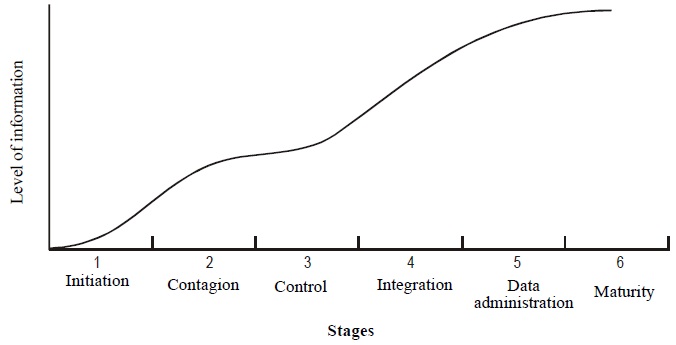Information system planning is focused on determining the information needs and also ensuring that information system planning aligns with the overall business planning.
For information system planning R.Nolan has given a model known as Nolan stage model. It initially had four stages of growth and later on, it was reviewed, and as a result, there is an addition of two intermediate growth stages.
Table of Content
The Nolan model basically describes in which stage organization’s information system exists. This will provide a base for planning to proceed to next stage of the growth. We can see the contribution of this model for MIS planning after going through each stage of Nolan’s model.
The Nolan stage model explains the evolution of information systems within an organization by considering the various stages of growth. This model was developed in the mid of seventies. Expenditure on information technology increases as the information system passes through various stages. Various stages of Nolan’s stage model is shown below:

Nolan Stage Model
- Stage 1 Initiation
- Stage 2 Contagion
- Stage 3 Control
- Stage 4 Integration
- Sage 5 Data Administration
- Stage 6 Maturity
Stage 1 Initiation
This is the first stage of Nolan’s model. This stage depicts that computer system is used for transaction-processing which is basically the bottom line of the organization hierarchy. At transaction processing level typically, a high volume of data processing is done in terms of accounting the business transactions, billing and payroll, etc.
So very little planning of information system is required. The users are mostly unaware of the technology. So new applications are development with the help of traditional languages like Cobol, Fortran, etc. System analysis and design has very few methodologies.
Stage 2 Contagion
This is the second stage of Nolan’s growth model, also known as expansion stage. It is related to unplanned and uncontrolled growth. Actually, at this moment the users have developed their interest to know the possibilities of it but still, they do not know much about its pros and cons.
The growth of large number of IT applications with a minimum check on whether they are required or not, are the key features of this stage. Technical problems with the development of programs appears. There was very little control of the development of information system as well as expenditure associated with IT.
Stage 3 Control
This is the third stage of Nolan’s stage model. Because of the unplanned growth, of a large number of IT applications as well as projects, a need arose to manage the information system and also the reorganization of data processing department.
The data processing manager becomes more accountable or responsible to justify the expenditure on information system development. The growth of projects is controlled by imposing changes on user department for information system development project and the use of computer services.
Users are witnesses of progress in the development of information systems. Pent-up repressed demand and frustration occur in user departments. Organizations are unable to apply cost-effectiveness criteria.
Stage 4 Integration
This is the fourth stage of Nolan’s model, known as the integration stage. At this stage data processing has a new direction. Information systems are more information-oriented, i.e., they lay importance on information product.
Because of this concept and to facilitate it, there is an introduction of interactive terminals in the user department, the development of database and the introduction of data communication technology has taken place. The controlled user departments are now in a position to satisfy the repressed demand for information support.
So there is a tremendous growing demand for IT applications. As a consequence of this, there is a hike in expenditure also. A new problem has emerged, i.e., redundancy of data.
Sage 5 Data Administration
This is the fifth stage of Nolan’s stage model. This stage did not exist in the initial model. This stage has come into existence to overcome and also to control the problem of data redundancy. At this moment it is realized that data is an important resource of the organization.
So it should be duly planned and managed. This stage is characterized by the development of an integrated database serving whole organization’s information need. It also develops an IT application to successfully access these databases. Users become more accountable for the integrity and appropriate use of the data and information resources.
Stage 6 Maturity
This is the sixth stage. This was added to the enhanced model. This stage indicates towards a mature organization, which took information system as an integral part of the organization functioning. It indicates that the application portfolio is complete and representative of an organization’s activity.
Actually, application portfolio matches with the overall objectives of the organization. Planning of the information system was coordinated and comprehensive because top management realized that information was an important resource.
Manager of information system is on the same footing as other managers of the organization. Thus, planning of the development of information system in the organization is built into the organization’s overall development.
Use of Nolan’s Model in Information System Planning
Nolan’s stage model gave an evolutionary explanation for information system development within an organization. In fact Nolan’s model is a contingency model that identifies a pattern of growth that an organization needs to go through before achieving maturity.
Every stage witnessed a learning process. It was not possible to skip any of the stages in the growth process. While progressing to next stage, the organization must go through each stage proceeding it. For example, if one wants to move to stage 4, one has to go through stage number 1, 2 and 3.
The model has been used for planning purpose. The model can be applied to identify the current stage of the growth. Also planning changes to move in a controlled manner to the next stage. This has implications for what has to be achieved in order to progress to the next stage.
Planning is required in the areas of application portfolio, technology used, the planning and control structure and the level of the user awareness and involvement. Manager should go for planning because it will speed up the progress process, i.e., move to the next stage and also accompanying organizational learning.
We know the model was developed way back, i.e., during 1970s and after that there was a tremendous change in the field of information technology. So this model incorporated the changed technology concepts in 1980s and 1990s information system.
Nolan’s model was mainly criticized on the following grounds
- It ignores the fact that advances in information technology made user self sufficient or now they are not dependent on computer centres.
- It ignores the fact that there has been tremendous development in the area of communication and local area networks which is used to PCs and other technologies together.
- It ignores the fact that new software development tools support the user.
Despite this criticism, the model finds its validity in many applications of information system planning till today. Every organization realizes that their information system has to undergo these stages. But how long it stays in each stage depends upon the learning process of the organization.
This model is used for IS planning where there is a shift of emphasis between the user and the computer centre in the process of growth and where there is more from concentration on processor technology to data management. At last we may say that this model helps a manager to be proactive.
Management Information Systems
(Click on Topic to Read)
- What is MIS?
- Requirements of Management Information System
- What is Risk Management?
- Nolan Six Stage Model
- What is Cloud Computing?
- Types of Information Systems: TPS, MIS, DSS, EIS
- Information Systems in Organisations
- Challenges Faced by Manager in Managing Information Systems
- Decision Making With MIS
- What is E-Governance?
- What is Green IT?
- What is Smart Cities?
- What is IT Infrastructure?
- What is Cloud Computing?
- Cloud Service Models
- Cloud Migration Challenges
- Security Threats Faced by Organization
- Managing Security of Information Systems
- Software Project Management Challenges
- What is Data Management?
- What is Database?
- What is Data Warehouses?
- Enterprise Resource Planning Systems




